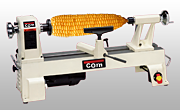Having chosen the software to drive the stepper motors, we now can configure a computer appropriate to run the software. The operating system will be Linux (I'm on Debian 7.11). Good news -- it's free! I know all you Windows users (or Mac users like me) will complain about having to learn something new. Just get over it.
For the computer hardware -- use some OLD (and I really do mean OLD) PC. If you don't have one laying around, you can usually get one for free by asking around. Our local Habitat for Humanity ReStore sells old computers with a flat panel display for $50.
For my approach, you MUST have a parallel port (one of those old 25 pin connectors). That's one reason for choosing an old computer. Some PCI parallel port cards will work with LinuxCNC (see the LinuxCNC forum for recommendations).
Note: Many newer computers (especially ones with multi-core processors) WILL NOT WORK!
My recommendation -- build your own computer with hardware that's proven to work well! You can build your own computer for well under $200. If this intimidates you, watch the short videos on Newegg. Here's the list of what I'm using:
- Intel D525MW 1.8GHz (Dual Core) Motherboard/CPU Combo for $79.99
- 4GB of RAM for $24.99 -- the exact offerings change, so use the Newegg Memory Finder to get a list. You don't really need 4GB -- 2GB would work fine if you want to save a few pennies.
- A box to put it in with a power supply for $49.99.
- A SATA hard disk -- I used an old 30GB disk from another old computer. You don't really need more than 8GB. A small SSD drive would be very nice and fast. If I didn't have access to an old hard disk, I would have bought an 8GB DOM SSD SATA (no cables -- it plugs into a socket on the board) for about $30 on eBay.
- Optional: CD drive -- You only really need this to load the operating system. What I did is "borrow" one from another computer and just connect the cables for the time I used it. Once you've got the operating system loaded, you'll probably never need it again.
- If you don't have a "free" keyboard or mouse, there are boxes of them at the Habitat for Humanity ReStore for $1 each. Likewise, internet cables are $1 so pick up a few.
Installing Linux and LinuxCNC is very straight-forward (follow the instructions on the LinuxCNC web site). Once you install that, be sure to do any updates that are available. There are a few special things you'll want do do as well:
- Disable hyper-threading: This is done with the Bios setup.
- Set the parallel port to EPP as recommended by Gecko (also done with the Bios setup).
- The LinuxCNC forums recommend that you limit the CPU to run the linux kernel with just one processor. The LinuxCNC wiki has an article on how to do this. I've been working with just the one CPU and it appears to run fine even though I'm hitting 100% CPU usage when making very fine resolution cuts.
It is my intention to use this little slave computer for the sole task of running LinuxCNC and controlling the stepper motors. I have a small flat-screen display connected to it where I can see the display while using the lathe. I don't really want to have to use the keyboard or mouse, but I need the mouse occasionally (like to shut down the computer). Having said that, there are a few things you can do to make this little slave machine easy to use:
- Set it up to automatically log into your account when you turn the power on.
- Have it automatically launch LinuxCNC on start-up. See the "Getting Started" manual for details
- Have the LinuxCNC window go to full screen size on the monitor as soon as it starts up. You do this by creating a new file in your home directory called .axisrc with the following line: root_window.tk.call("wm","geometry",".","1024x768") where 1024x768 is replaced by your monitor size.

